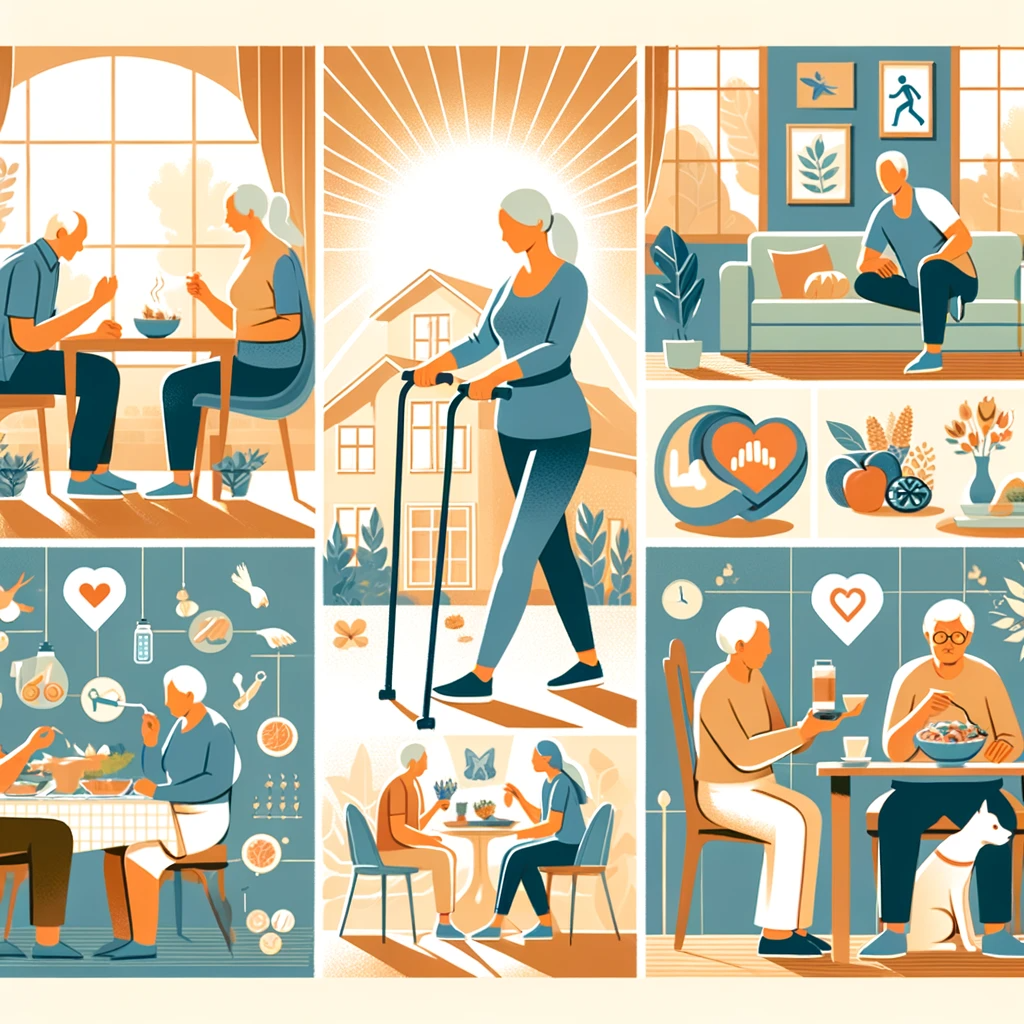Aging with Dignity: A Comprehensive Guide to In-Home Care for Elderly Loved Ones
This guide explores the nuances of in-home care for elderly patients, highlighting the importance of adapting homes for safety, managing healthcare needs, and maintaining a healthy lifestyle. It emphasizes the empowerment in-home care provides to seniors

As our society evolves, the preference for aging in place – remaining in the comfort and familiarity of one's own home during the golden years – has become increasingly prevalent. According to AARP's November 2021 "Home and Community Preferences" survey, a significant majority of U.S. adults, especially those over 50, express a desire to age in their own homes.
This trend underscores the critical role of family caregiving in making this aspiration a reality. The 2020 Caregiving in the U.S. report by AARP and the National Alliance for Caregiving reveals that 43% of family caregivers tend to relatives in their homes, while 40% reside with the care recipient. The journey of helping a loved one age in place can range from periodic check-ins to more involved tasks like bathing, meal preparation, medication management, and even administering injections. This article aims to provide a comprehensive guide to ensure your elderly family members can remain at home safely and comfortably for as long as possible.
Questions That Every Caregiver Should Ask Before The Start of The Journey
Developing a Comprehensive Care Plan
Effective in-home care begins with a well-thought-out plan that addresses both immediate needs and future contingencies. This plan should consider daily routines, such as doctor's appointments and medication refills, while also preparing for potential emergencies. Creating a care team comprising family members, friends, and professionals can offer a robust support system. Each team member should have a clear understanding of their roles and responsibilities. It's crucial to determine which tasks each person is willing to undertake, including those who may live far away but can manage remote tasks like bill payments and scheduling medical appointments.
Self-assessment is equally important. As a caregiver, you need to be honest about what you are comfortable and capable of doing. If certain caregiving tasks are beyond your comfort zone, such as assisting with personal hygiene, it's essential to identify another team member who can take on these tasks or consider hiring a professional caregiver. Documenting the care plan is vital for ensuring that everyone involved, including your loved one, understands and agrees to the proposed care strategy. Remember, this plan is not static; it should evolve as your relative’s needs change over time.
I created the New to Caregiving Course to introduce you to the things you need to put in place as you start your caregiving journey. Start your home health care notebook to get organized.
Mindfulness Based Stress Reduction and Caring Slows Cognitive Decline
Adapting the Home for Safety and Comfort
The physical environment of a home plays a significant role in the safety and well-being of aging adults. Those with mobility issues, impaired vision, or hearing loss require a home environment that minimizes risks. Consulting professionals like occupational therapists, geriatric care managers, or aging-in-place specialists can provide valuable insights into necessary home modifications.
Simple fixes can make a big difference in preventing falls – a common risk for seniors. Removing tripping hazards, ensuring adequate lighting, and installing adjustable shower seats, grab bars, and handrails are essential steps. For those with dementia, additional precautions like remote door locks, disabling stoves when not in use, and setting water heater temperatures to safe levels are necessary to prevent wandering and injuries.
In cases where physical limitations are more pronounced, more extensive modifications may be needed. These could include installing wheelchair ramps, adjusting countertops, and widening doorways to accommodate mobility aids.
Questions To Ask Your Doctor About Fall Prevention

Managing Healthcare Needs at Home
Caring for an aging or chronically ill family member often entails handling basic medical tasks and managing a complex array of medications for various ailments. Key to this aspect of caregiving is staying organized and knowing how to access necessary help.
Stay on top of meds: An updated medication list is crucial. This list should include the name, dosage, prescribing doctor, and other pertinent information. It's a valuable document to have on hand for doctor's appointments and in case of emergencies.
Be ready for medical tasks: Following hospitalization, many family caregivers find themselves performing tasks like injecting medicines or inserting catheters at home. It's vital to receive thorough instructions and demonstrations of these procedures before leaving the medical facility.
Set up home health services: Medicare and other insurance options may cover certain in-home services deemed medically necessary. These can include part-time or intermittent skilled nursing care or therapy services. A patient who is considered homebound, or unable to make an office visit, may qualify for ongoing in-home care services.
Maintaining a Healthy Lifestyle for Caregivers and Seniors
The role of a caregiver often transcends medical needs, encompassing the overall well-being of the elderly person, which includes their mental and physical health. However, it's equally important for caregivers not to neglect their own health.
Address social needs: Combatting isolation and loneliness is crucial as these factors can significantly impact health. Engaging in community arts programs for seniors, arranging visits from friends and relatives, or enjoying meals together can greatly enhance the social life of your loved one.
Manage nutrition: Pay attention to dietary restrictions and promote a balanced diet, avoiding processed foods. Home-delivered meal programs can be a valuable resource, and ensuring adequate hydration is essential to prevent complications like fainting and headaches.
Encourage exercise: Mobility helps older people maintain strength, balance, and brain health. Exercise regimens should be tailored to the individual's abilities and approved by a doctor. Activities can range from walking and seated yoga to swimming or light weightlifting.
Establish boundaries: Especially in shared living situations, maintaining privacy and personal space is key. Scheduling time together as a family or couple is important for everyone's well-being.
Caregiver Checklist To Create Goals
Create A Person Centered Profile For Your Family Member
Embracing the Transition to In-Home Care
Transitioning to in-home care requires mental preparation and acceptance of new caregiving dynamics. Trusting someone else to care for your loved one can be challenging but is often necessary for their best care.
Mental Preparation: Accepting your limitations as a caregiver and trusting a professional to assist is crucial. This might include sharing intimate details about your loved one's life and condition, and stepping back to allow the professional caregiver to work effectively.
Practical Steps: Before the arrival of an in-home health aide, organize all necessary medical supplies, medication lists, emergency contacts, and doctor information. Keep this information accessible, like on the refrigerator or near the phone. If the health aide is live-in, consider their accommodation and establish house rules for a smooth cohabitation.

Maximizing the Benefits of In-Home Healthcare
To make the most out of in-home healthcare, clear communication and mutual understanding between the family and the healthcare provider are essential.
Set Clear Expectations: Begin with a comprehensive walkthrough of the home, discussing the division of labor and house rules. Clarify the medical and non-medical services expected from the in-home health aide.
Service Agreement: Document all details of the care arrangement in a service agreement. This clarifies the role and duties of the healthcare provider and sets clear expectations. This document can be a reference for resolving any future issues.
In-home care empowers elderly patients to age with dignity in the comfort of their homes. It's a journey that demands patience, preparation, and the willingness to adapt. By following these guidelines, families can ensure a smooth transition to in-home care, providing their loved ones with the quality, personalized care they need while maintaining their independence and quality of life. Remember, you're not alone in this journey – there's support available every step of the way.
I encourage every caregiver to take the How to Become a Patient Care Advocate Course. This is a self directed care
Before you start to look for home health care- know the difference in services provided.
Skilled Home Health Care
Developing a Comprehensive Care Plan
Importance of Short-Term and Long-Term Planning:
A comprehensive care plan for an aging loved one should encompass both immediate needs and future contingencies. Short-term planning might include managing daily living tasks such as meal preparation, medication reminders, and medical appointments. Long-term planning, on the other hand, considers progressive changes in health status, potential for increased care needs, and even eventual transitions to more intensive care options like assisted living facilities or hospice care. Anticipating these changes ensures that the necessary resources and support systems are in place when they're needed, thereby reducing future stress and uncertainty.
Early Indicator For More Help Assessment Tool
Involving a Team of Family, Friends, and Professionals:
Creating a care team is crucial in providing comprehensive and consistent care. This team should include family members, friends, and healthcare professionals like geriatric care managers, home health care providers, and possibly social workers. Each member brings unique skills and perspectives. For instance, a professional caregiver might offer specialized care and daily living assistance, while a family member could provide emotional support and companionship. Friends might assist with transportation or grocery shopping. The involvement of diverse team members ensures a holistic approach to caregiving.
Creating a Care Team Partner Support Group:
An essential component of the care team is a support group for the partners involved in caregiving. This group can consist of family members, close friends, and even members of the wider community who are involved or have experience in caregiving. The purpose of this support group is to provide emotional and practical support, share responsibilities, and offer a platform for discussing challenges and solutions. Regular meetings, whether in person or virtual, can be a vital source of encouragement and advice, helping to alleviate the sense of isolation often felt by caregivers.
The Significance of Honest Self-Assessment:
Caregivers must honestly assess their capabilities and limitations. It’s important to acknowledge that not everyone is equipped for tasks like personal care services or managing certain health care needs. Recognizing one's comfort level with various caregiving tasks is crucial for both the caregiver's and the care recipient's well-being. If a task is beyond a caregiver’s ability, it’s essential to communicate this to the care team and make arrangements for professional assistance or support from other team members.
Preparing For An Unexpected Trip To The Hospital
Documenting and Updating the Care Plan Regularly:
A written care plan serves as a roadmap for everyone involved in the caregiving process. It should detail the daily routine, medical care needs, emergency procedures, and contact information for all care providers and family members. This document must be easily accessible to the entire care team. Regularly reviewing and updating the care plan is vital as the needs of the aging adult may change over time. Updates might include changes in medication, adjustments in personal care needs, or shifts in the level of supervision required. Keeping the care plan current ensures that all team members are informed and can provide the best possible care.
What is Non Medical Home Care?
Adapting the Home for Safety and Comfort
Professional Assessments for Home Safety:
To ensure the safety and comfort of aging adults at home, it's essential to start with a professional assessment. Specialists like occupational therapists, geriatric care managers, or aging-in-place specialists can evaluate the home environment and recommend necessary modifications. These professionals are trained to identify potential hazards and suggest practical solutions that cater to the specific needs of the elderly, considering factors like mobility, vision, and cognitive abilities. Their expertise can be invaluable in creating a safe, accessible, and comfortable living space.
Simple Modifications for Fall Prevention and Dementia Care:
Fall prevention is a critical aspect of home safety for older adults, particularly those with mobility challenges or conditions like dementia, which can increase the risk of falls. Simple, low-cost modifications can significantly reduce this risk:
- Removing Trip Hazards: Clearing pathways of obstacles like cords, throw rugs, and clutter is a primary step.
- Lighting: Ensuring adequate lighting throughout the home, particularly in stairways and hallways. Installing automatic night-lights can help prevent falls during nighttime movements.
- Bathroom Safety: Installing grab bars in the shower and near the toilet, as well as using non-slip mats, can prevent slips in the bathroom.
- Flooring: Replacing slippery flooring with non-slip options is also beneficial.
For dementia care, additional modifications might include:
- Safety Locks: Installing locks on cabinets that contain harmful products.
- Alarm Systems: Setting up alarms on doors to prevent wandering.
- Simplified Environment: Creating a clutter-free environment that is easy to navigate and reduces overstimulation.
Major Home Adaptations for Severe Physical Limitations:
When dealing with severe physical limitations, more extensive home modifications may be necessary:
- Wheelchair Accessibility: This might include installing ramps for entry and exit points, widening doorways, and modifying thresholds for easy wheelchair access.
- Bathroom Adaptations: For those who use a wheelchair or have severe mobility issues, roll-in showers, higher toilet seats, and sink modifications can be essential.
- Kitchen Modifications: Adjusting counter height and ensuring that appliances are accessible can aid in maintaining independence in meal preparation.
- Flooring: Replacing carpet with smooth flooring can make wheelchair movement easier.
- Technology Aids: Implementing smart home technologies for controlling lights, thermostats, and other appliances can enhance independence and safety.

Adapting a home for an aging adult is about creating a safe, comfortable, and functional environment that caters to their evolving needs. By combining professional assessments with practical modifications and major adaptations as necessary, caregivers can significantly enhance the quality of life and independence of their elderly loved ones, allowing them to age in place safely and with dignity.

Managing Healthcare Needs at Home
Organizing Medication and Medical Tasks:
Effective management of medication is a cornerstone of in-home healthcare, especially for older adults with chronic conditions. The complexity of managing multiple prescriptions necessitates a structured approach:
- Medication Lists: Keeping an up-to-date list of all medications, including dosages, prescribing doctors, and the purpose of each medication. This list should be readily accessible and shared with all family caregivers and healthcare providers involved.
- Medication Reminders: Setting up systems for medication reminders, such as pill organizers, digital alerts, or apps, can help ensure that medications are taken correctly and on time.
- Monitoring: Regular monitoring for side effects or interactions between different medications is crucial. Family caregivers or professional caregivers should be aware of any changes in the patient's condition that might be related to medication.
Beyond medication, organizing medical tasks such as wound care, physical therapy exercises, or monitoring vital signs is vital. This may involve training for family caregivers or the involvement of skilled nursing care.
Questions to Ask About Your Medications
Tips for Medication Safety and Storage
Utilizing Medicare and Other Resources for Home Health Services:
Many aging adults are eligible for home health services through Medicare or other insurance plans. Understanding and utilizing these resources can greatly aid older adults in managing healthcare needs at home:
- Medicare Coverage: Medicare often covers services like part-time skilled nursing care, physical therapy, occupational therapy, and speech-language pathology services, provided they are prescribed by a doctor and deemed medically necessary.
- Exploring Additional Resources: Other resources might include Medicaid (for those who qualify), long-term care insurance, and community-based programs that offer support for specific conditions like Alzheimer's or Parkinson's disease.
- Navigating Services: It's important to navigate these services effectively, which may require assistance from a social worker or a geriatric care manager to ensure that the elderly individual receives all the benefits they are entitled to.
The Role of Professional Caregivers and Agencies in Providing Specialized Care:
Professional caregivers and home care agencies play a pivotal role in managing healthcare needs at home, particularly when specialized home care assistance is required:
- Skilled Nursing: For medical tasks beyond the scope of family caregivers, such as administering injections or wound care, skilled nursing provided by licensed nurses is essential.
- Therapy Services: Physical, occupational, and speech therapy can be crucial for recovery after an illness or injury and for managing chronic conditions. These services can often be provided at home by licensed therapists.
- Customized Care Plans: Professional caregivers work with the family and healthcare providers to develop and implement customized care plans that address the specific health needs of the individual.
- Respite Care: Professional caregivers can also provide respite care, giving family caregivers a much-needed break, which is crucial for their well-being and the sustainability of the care they provide.
Managing healthcare needs at home requires a multi-faceted approach, involving careful organization of medication and medical tasks, effective utilization of available resources like Medicare, and the integration and assistance of professional caregivers and agencies when specialized care is needed. This holistic approach ensures that aging adults receive comprehensive, personalized care, enhancing their quality of life and enabling them to age in place with dignity and comfort.
Private Duty Hiring Package Template
Maintaining a Healthy Lifestyle for Caregivers and Seniors

Addressing Social, Nutritional, and Exercise Needs of the Elderly:
A holistic approach to senior caregiving extends beyond medical care to encompass the overall well-being of seniors, which includes their social, nutritional, and physical fitness needs.
- Social Engagement: Social interaction is vital for the mental health of aging adults. Activities such as participating in senior community arts programs, scheduling visits with friends and family, or simple outings can significantly reduce feelings of loneliness and isolation. In cases of limited mobility, technology can be leveraged for virtual social interactions.
- Nutritional Needs: Proper nutrition is crucial for the elderly. Caregivers should ensure that dietary restrictions are observed and that a balanced diet is maintained. This may involve preparing meals that cater to specific health conditions, avoiding processed foods, and ensuring the intakof essential nutrients. Home-delivered meal programs can be beneficial, especially for caregivers who may have time constraints.
- Exercise Routines: Physical activity is key to maintaining strength, balance, and overall health. Exercise routines should be tailored to the individual’s abilities and medical conditions, with a doctor’s approval. Activities might include walking, seated yoga, light weightlifting, or swimming. Regular physical activity not only improves physical health but also enhances cognitive function and emotional well-being.
99 Activities to Do with a Person with Dementia
Setting Boundaries for Privacy and Personal Space:
In caregiving situations, especially where the caregiver and the senior share a living space, it’s essential to establish boundaries to maintain a healthy relationship and ensure personal space for both parties.
- Living Arrangements: Designating specific areas as private spaces can help maintain individuality and independence for both the caregiver and the senior. This is particularly important in shared living arrangements to prevent feelings of overcrowding and to respect each other's privacy.
- Time Management: It’s important to establish routines that allow for personal time. This might include setting aside time for hobbies, relaxation, or social activities independent of caregiving responsibilities.
The Importance of Respite Care for Caregiver Well-being:
Caring for an elderly loved one can be both physically and emotionally demanding. Respite care is essential for the well-being of caregivers.
- Taking Breaks: Regular breaks prevent caregiver burnout and help maintain the quality of care provided. Respite care can be arranged through professional services or by other family members stepping in to provide temporary relief.
- Support Groups: Caregivers should consider joining support groups where they can share experiences, gain advice, and receive emotional support from others in similar situations. These groups can be a valuable resource for managing stress and finding balance.
- Healthcare for the Caregiver: Caregivers must also attend to their own health needs, both physical and mental. This includes regular medical check-ups, mental health support if needed, and engaging in activities that promote their own well-being.
Conclusion:
Maintaining a healthy lifestyle for both seniors and their caregivers involves a comprehensive approach that addresses social, nutritional, and physical needs while respecting personal boundaries and understanding the importance of respite care. By attending to these aspects, the caregiving experience can be enriching and sustainable, enhancing the quality of life for both the caregiver and the senior.

Embracing the Transition to In-Home Care
Mental Preparation for Family Caregivers:
The transition to in-home care is a significant change, both for the aging adult and the family caregivers. Mental preparation is key to ensuring a smooth transition.
- Acknowledging Change: Caregivers must acknowledge the shift in dynamics as they take on more responsibilities or collaborate with professional caregivers. Accepting this change is the first step in adapting to the new caregiving role.
- Setting Realistic Expectations: Understanding the realities of in-home care, including the challenges and limitations, helps in managing expectations. It’s important to recognize that while in-home care can greatly improve the quality of life for seniors, it also requires patience, effort, and sometimes compromises.
- Emotional Resilience: Developing emotional resilience is crucial. Caregivers should be prepared for good days and challenging ones, understanding that caregiving can be a rewarding yet emotionally taxing journey.
Trust and Communication with In-Home Health Aides:
Establishing a relationship of trust and open communication with in-home and home health care aides is fundamental for effective care.
- Building Trust: Trust is built over time through consistent, open communication and observing the competence and compassion of the health aides. Family caregivers should have regular check-ins and openly discuss any concerns or preferences regarding care.
- Clear Communication: Articulate clearly the needs and preferences of the senior, as well as any specific routines or procedures that are important to them. This ensures that the care provided aligns with the senior’s requirements and the family’s expectations.
- Respecting Professional Expertise: While family caregivers know their loved ones best, it’s also important to respect the professional expertise of in-home health aides. Their training and experience are valuable in providing specialized care and managing complex health needs.
Practical Steps for Preparing the Home for In-Home Care:
Preparing the physical environment is crucial for effective in-home care.
- Safety Modifications: As discussed earlier, ensure the home is safe for the senior. This may involve installing grab bars, ramps, and other safety features.
- Organizing Medical Information: Have all medical information, including medication lists, doctor’s contacts, and medical history, organized and accessible. This is crucial for in-home health aides to provide appropriate care.
- Designating Spaces: If the health aide will be a live-in caregiver, designate spaces for their use to ensure privacy and comfort for both the caregiver and the senior.
- Emergency Preparedness: Ensure all family members and in-home health aides are aware of emergency procedures, including contact numbers and locations of emergency supplies.
Embracing the transition to in-home care requires mental preparation, building trust and open communication with in-home health aides trained caregivers, and taking practical steps to prepare the home. By addressing these aspects, families can facilitate a smoother transition, ensuring that their loved ones receive the best possible care in the comfort of their home.
By considering these factors, family caregivers can more effectively navigate the complexities of in-home care, creating a nurturing and supportive environment for their elderly loved ones.
Maximizing the Benefits of In-Home Healthcare
Establishing Clear Expectations and House Rules:
Setting clear expectations and house rules is essential for a harmonious in-home care environment. This clarity helps in avoiding misunderstandings and ensures that everyone’s needs are respected.
- Defining Responsibilities: Clearly outline the responsibilities and duties of the in-home health aides. This might include specifics on medical care, meal preparation, personal care, and other services.
- House Rules: Establish house rules regarding the use of shared spaces, appliances, and schedules. This is particularly important in shared living situations to ensure respect for everyone’s privacy and routines.
- Involving the Senior: Whenever possible, involve the elderly patient in these discussions to respect their preferences and promote their independence and dignity.

Creating a Service Agreement with In-Home Health Aides:
A formal service agreement with in-home health aides is a critical tool for ensuring that all parties have a mutual understanding of the care arrangement.
- Documenting Roles and Expectations: The agreement should document the roles, responsibilities, and expectations for the in-home health aide, including hours of service, specific tasks, and any other relevant details.
- Legal and Financial Terms: Include any legal and financial terms, such as rates of pay, overtime, and terms of termination.
- Review and Update: The service agreement should be reviewed periodically and updated as needed, especially if there are changes in the health condition or care needs of the senior.
The Importance of Ongoing Communication and Adjustments:
Effective in-home care is dynamic and requires ongoing communication and flexibility.
- Regular Check-ins: Regular meetings or check-ins with the in-home health aides and family members help in addressing any concerns or changes in the care plan.
- Adaptability: Be prepared to adapt the care plan as the needs of the senior change over time. This might involve increasing care hours, incorporating new medical treatments, or adjusting daily routines.
- Feedback Loop: Encourage a feedback loop where the in-home health aides feel comfortable sharing observations and suggestions based on their professional experience.
Conclusion
The Empowering Impact of In-Home Care on Elderly Patients:
In-home care has a profoundly positive impact on elderly patients. It allows them to age in the comfort of their own homes, surrounded by familiar settings and memories. This environment can enhance their mental and emotional well-being, providing them with a sense of independence and dignity.
Encouragement for Families to Embrace this Journey with Their Loved Ones:
Families are encouraged to embrace the journey of in-home care. While it can be challenging, the rewards are significant. It strengthens family bonds, allows for personalized care tailored to the individual’s needs, and provides peace of mind knowing that loved ones are receiving compassionate care in the safest and most comfortable environment – their home.
In-home care, when effectively managed, offers a unique opportunity to enhance the quality of life for elderly patients. It empowers them to maintain their independence and live their golden years with dignity, surrounded by the love and care of their families.
The Empowering Impact of In-Home Care on Elderly Patients:
In-home care profoundly influences the lives of elderly patients, offering them a sense of empowerment and autonomy that is often lost in more institutional settings. This form of care allows seniors to remain in the comfort and familiarity of their own homes, a factor that significantly contributes to their emotional and mental well-being. The ability to maintain a sense of normalcy, follow personal routines, and stay in a beloved environment can have a tremendous impact on their overall quality of life.
The personalized nature of in-home care ensures that the unique needs and preferences of each individual are met. Elderly patients receive one-on-one attention and care tailored specifically to their conditions and preferences. This personalization not only enhances their physical health but also provides a sense of dignity and respect. Furthermore, staying at home can often mean remaining close to cherished memories, personal belongings, and perhaps even community ties, which is invaluable for many seniors.
Create A Person Centered Profile For Your Family Member
Encouragement for Families to Embrace this Journey with Their Loved Ones:
For families, the decision to opt for in-home care is often accompanied by apprehension and uncertainty. However, embracing this journey can bring numerous rewards. It provides families with the opportunity to be closely involved in the care of their loved ones, fostering deeper connections and understanding. Family members often find that this journey, while challenging, is also filled with moments of joy, learning, and growth.
In-home care also offers families the peace of mind that comes from seeing their loved ones receive attentive and compassionate care in a familiar setting. It eliminates the concerns often associated with external care facilities, such as the quality of care and the potential for loneliness or neglect. Moreover, the flexibility of in-home care allows family members to balance their own lives with their caregiving responsibilities, with the support of professional caregivers when needed.
The journey of in-home care is a testament to the strength and resilience of families as they navigate the complexities of aging. It calls for patience, empathy, and adaptability, but the rewards — in terms of enriched family relationships and the satisfaction of providing loving care — are immeasurable.
In Summation:
In-home care represents a significant shift in how we approach the care of our aging population. It’s a model that honors the individuality and dignity of each senior, while also acknowledging the crucial role families play in the caregiving process. As we continue to evolve in our understanding and provision of elder care, the in-home model stands out for its ability to meet the physical, emotional, and social needs of elderly patients in a manner that is both empowering and deeply humane.
Our Resources section can help you find the information and tools that you need. We have courses, videos, checklists, guidebooks, cheat sheets, how-to guides and more.
You can get started by clicking on the link below. We know that taking care of a loved one is hard work, but with our help you can get the support that you need.
Click here to go to Resources Section now!
You might also like this article:




